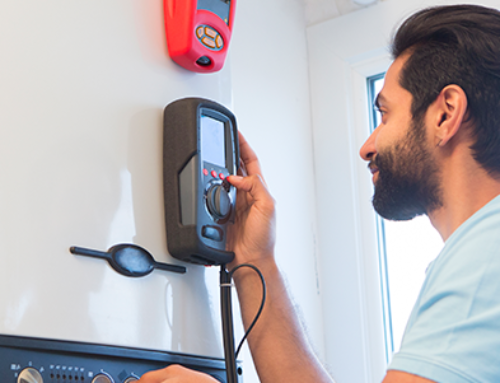Are you a repair shop or service centre owner?
If so, it’s important to know a fire can occur when vehicles and equipment experience electrical malfunctions. Motor vehicles, marine vehicles, recreational vehicles, and equipment (like power tools and ventilation systems) all contain various electrical components, such as batteries, cables and wiring, power generators, and electronic control units. Your property could be consumed by a fire if one of these electrical sources come in contact with extremely flammable materials in a vehicle or in your shop.
Imagine this: A customer brings in a vehicle—with no immediate visible issues—to a repair shop. Later, the vehicle catches on fire and causes property damage. After a thorough investigation, it is discovered the cause of the fire was electrical in nature, due to a battery cable from a charger being left on all night. Charging electrical systems can build up heat, especially if damaged or if safety components like fuses fail. This heat build-up can cause components to melt and eventually ignite combustible material or even cause explosions. To help protect your business from electrical vehicle fires you should consider some general precautions, including:
- Develop a written handling procedure of vehicles for your employees.
- Enforce regular inspections on all vehicles and equipment on your property.
- Ensure only qualified employees disconnect batteries or make other alterations to vehicle systems.
How to help avoid electrical source vehicle fires
There are a few key steps you can take to help avoid electrical fires. These include:
Disconnect power supplies
A good risk management practice is to disconnect batteries from vehicles as soon as they’re brought into your business. This is especially important for vehicles or equipment that are being serviced due to electrical issues. Disconnecting a power supply and removing batteries also helps prevent battery drainage. Most damaged vehicles towed in from accident sites should already have the battery disconnected, however, it is still your responsibility to ensure this has been done properly.
For your personal equipment, such as trucks or other motorized equipment, consider installing a device called a battery cut-off switch. When this device is present, the battery power supply can be disconnected to help prevent an electrical vehicle fire. Battery cut-off switches are made to disconnect a battery’s power supply quickly and easily. Cut-off switches are also an effective loss prevention tool for deterring theft of vehicles and equipment. The mechanism on many cut-off switches can be completely removed or locked, making it nearly impossible to start a vehicle or equipment.
Prioritize battery safety
Short circuits, overcharging and other malfunctions can produce heat buildup, which may lead to fires, explosions, and ultimately, property damage. Only qualified personnel should be working on the electrical system and battery of any vehicle. When working with batteries, enforce the mandatory use of personal protective equipment (PPE) because batteries can contain toxic fumes and acid that have been linked to lung damage, blindness, and burning or scarring of the skin.
Installing and removing vehicle batteries
- Shut down all related electrical loads prior to performing battery maintenance.
- Always disconnect the negative (black) terminal connector before connecting or removing the positive (red) terminal connector. This can prevent an electrical arc from occurring should a metallic tool, like a wrench, touch a grounded surface.
Have safety guidelines when charging batteries
When charging batteries, a few guidelines that may help keep you safe are:
- Never charge batteries during non-business hours in case no one is there to monitor.
- When charging batteries during business hours, remember to first connect the charger connectors to the battery and ensure the charging circuit isn’t energized.
- Follow the charger’s operating instructions and make sure the connections are to the correct polarity.
- Unplug the charger at the end of the workday or when it cannot be supervised.
- Unattended and unobserved charged electrical systems, such as those found in a vehicle, can be a significant hazard if there’s unknown damage or a malfunction. Disconnecting the power source from the potential ignition point can reduce the hazard significantly.
- Never leave a charged or charging battery unattended overnight in a vehicle stored within your building.
Use proper maintenance procedures
- Before performing maintenance or repairs, ventilate the battery compartment as batteries can vent hydrogen gas, which can accumulate around the battery compartment.
- Ensure there are no possible malfunctions or any damage to the electrical system before reconnecting the battery and storing the vehicle outside.
The batteries and electric systems discussed above do not include specialized batteries, hybrid vehicles, or fully electric vehicles. Work on such specialized batteries and vehicles requires specialized training and equipment with significantly different safety practices.
Ensure that you’re protected
Despite your best efforts to prevent electrical source vehicles fires, sometimes things can still go wrong. That’s when insurance can be helpful. To learn more about how a tailored policy can help protect you, your employees, and your bottom line, visit our Automotive Repair Shop Insurance page today!
This blog is provided for information only and is not a substitute for professional advice. We make no representations or warranties regarding the accuracy or completeness of the information and will not be responsible for any loss arising out of reliance on the information.






